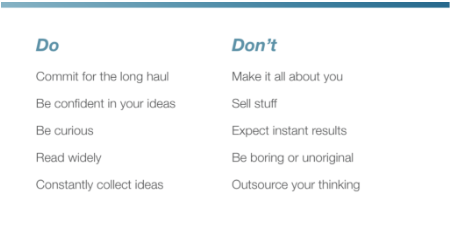Thought leadership is a remarkably resilient idea in the fickle, fashion-conscious world of marketing tactics. If you’re in B2B marketing or a clearly defined market niche, it’s a safe bet you need a thought leadership strategy. But what exactly is thought leadership, and how do you get it right? Read on for a quick summary of the essential dos and don’ts for thought leadership strategy and best practices.
Defining thought leadership
CEOs and executive teams love thought leadership. They want it, expect it to happen quickly and get disappointed when it fails to materialise. So the first step for anyone guiding a team of talented, insightful leaders is to get everyone on the same page. Are they using thought leadership as a substitute for press coverage, positive customer feedback or an opportunity to inspire employees? Perhaps in the social media age, they’re confused by paid social celebrities who spruik consumer products for the highest bidder?
Taking our cue from this fun reference, here’s a definition to help sort things out.
A thought leader is an influencer.
This person has the authority, confidence and insight needed to capture and retain the attention of a target audience. It could be the chief executive, an industry evangelist, marketer, head of communications, researcher or product specialist.
This person embodies a deep knowledge of the subject matter, is able to speak about its history in context and credibly predict future trends.
This ability to cut through with original ideas and influence a professional or social community is one of the most critical, in-demand leadership traits. We’re hungry to know why a brand, a product, a big idea or a person is different. Why should we give this idea our attention?
A thought leader has the answers.
Why it matters
A B2B Thought Leadership Impact Study published in 2020 by Edelman and LinkedIn examined the impact of thought leadership.
It reported 48 percent of B2B professionals consumed more than 1 hour of thought leadership content each week. These same people reported it influenced 49 percent of their sales decisions. The only downside was just 15 percent rated thought leadership content as having excellent quality.
That sounds like a low bar to clear and an opportunity to impress!
How to get it right
Step 1: What’s your one big idea?
I’m a big believer in the power of a single idea expressed very clearly. One blog post should be underpinned by one central idea. One video tells one story. A powerpoint slide has just one take-home message.
So what’s your big idea? If it helps, begin with your passions. What big trends are you following, and how can you break them down into small bite-sized chunks?
Step 2: Do the 3Ds
Discover. Develop. Distribute.
It helps to break down your thought leadership content strategy into these three stages.
- Discover
Subscribe to newsletters, read widely and collect as much information about your favourite topic. Think of it like a university assignment: gather your sources and look for new, surprising ideas that impress you. If you’re inspired, others will follow.
Discovery is as simple as asking yourself two questions:
- What do I want to say?
- What is my target audience interested in?
The point of overlap between the answers to these two questions will give your thought leadership relevance and power.
- Develop
Refine, simplify and develop your ideas. The best way to think about this stage is to create connections and observations between different, or conflicting ideas.
For example, I’ve been fascinated by a unique aspect of our humanity. We can simultaneously hold two conflicting ideas in our head, an idea called cognitive dissonance. To develop this idea, you could look at how this concept influences industry trends or customer behaviour. What surprising findings could inspire people?
Here’s a quick step-by-step guide to help:
- Brain dump
- Filter your thoughts
- Consider content type
- Interview / brainstorm
- Write, rewrite, edit
- Distribute
Next up, distribute. You’ve written (or had ghost-written for you) a great post, recorded a podcast or filmed an inspirational selfie video.
Your goal isn’t to become insta-famous. You want to reach the right people and the right people. That means finding the right people who can help publish and amplify your ideas so that the right eyeballs or ears find your content. Don’t overlook the
Step 3: Listen and learn
It’s easy to overlook this final stage. The only way to improve, refine and make a greater impact is listen. What are people saying about your ideas? What words are they using? What insights can you gather from the data?
If you’re struggling to get meaningful feedback, be proactive. Ask five trusted friends, colleagues or partners for candid responses.
I rarely make this a complicated process. Try this approach:
- Ask for a rating out of 10.
- What one idea was meaningful to you?
- What’s one thing I could do to improve?
It’s surprising how these three simple questions, asked regularly, can help you constantly improve.
Bonus ideas.
In September 2020, our Brand Storytelling Masterclass focused on the essentials of thought leadership.
Here’s my list of Dos and Don’ts to stick up next to your desk.

Good luck, and remember one final idea. We love influencers who are real, tell their own stories and tell us why ideas matter. That is, be yourself.
In the world of B2B marketing communications, it can be a radical idea but experience show fortune favours the brave.
Onwards,
Mark
Author: Mark Jones
For more information visit: Brand Storytelling, Communications & Marketing
